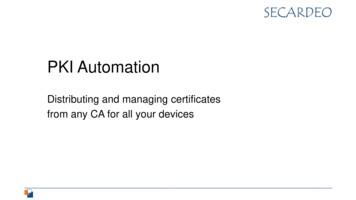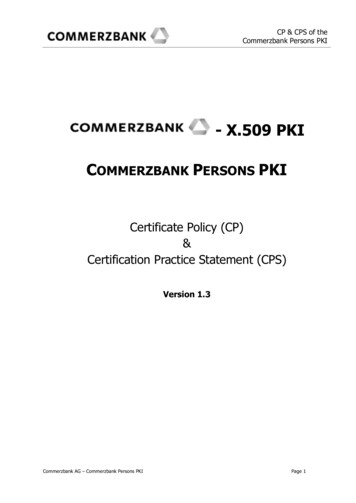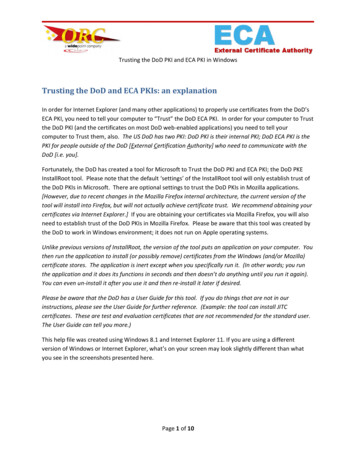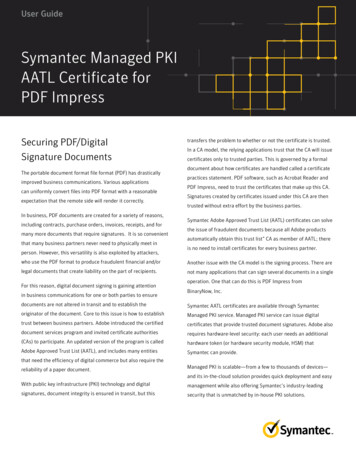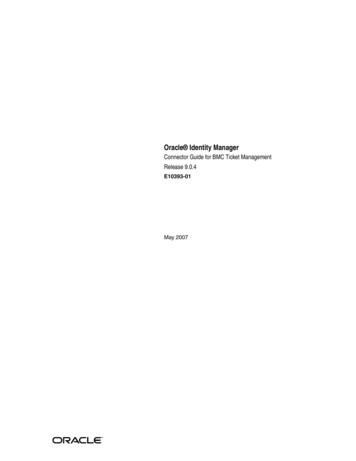
Transcription
EST compared to SCEP, CMC and CMPWhite PaperPKI: Simplify Certificate Provisioning with ESTWhat You Will LearnThe concept of a public key infrastructure (PKI) has existed for a long time. The PKI authenticates the identity ofusers and devices by means of signed public key pairs in the form of digital certificates.Recently, the Internet Engineering Task Force (IETF) introduced the Enrollment over Secure Transport (EST) protocolto provision these certificates. In this white paper we discuss the advantages of EST. We also compare it with othercertificate provisioning standards, namely: Simple Certificate Enrollment Protocol (SCEP)Certificate Management Protocol (CMP)Certificate Management over Cryptographic Message Syntax (CMC)ContentsIntroduction .2EST .2SCEP .2CMC and CMP .3Comparisons .3EST Versus SCEP .3EST Versus CMC and CMP .5Adoption .5Conclusion .6References .6Acknowledgments .7Cisco and the Cisco logo are trademarks or registered trademarks of Cisco and/or its affiliates in the U.S. and other countries. To view a list ofCisco trademarks, go to this URL: www.cisco.com/go/trademarks. Third-party trademarks mentioned are the property of their respective owners.The use of the word partner does not imply a partnership relationship between Cisco and any other company. (1110R) 2016 Cisco Systems, Inc. All rights reserved.
EST compared to SCEP, CMC and CMPIntroductionCertificates have been used to authenticate devices and individuals for a long time. They are used to prove theidentity of a device in the 802.1AR standard of the Institute of Electrical and Electronics Engineers (IEEE). They arealso widely used in Transport Layer Security, VPNs, and many other areas that require authentication. Thecertificates are usually generated by a trusted entity or certificate authority (CA), and they can be validated using aPKI root of trust and a certificate chain.Ubiquitous as certificates are, the PKI also needs a mechanism that can securely provide a certificate to an entity. Aregistration authority (RA) often serves as an intermediary. It can authenticate the client before getting a certificatefrom the CA (Figure 1).Figure 1. Common High-Level PKI ArchitectureESTThe most recently defined protocol that provides certificate provisioning is Enrollment over Secure Transport, IETF’sRFC 7030. EST profiles certificate enrollment for clients using Certificate Management over Cryptographic MessageSyntax (CMC) over a secure transport. According to the IETF, EST “describes a simple, yet functional, certificatemanagement protocol targeting Public Key Infrastructure (PKI) clients that need to acquire client certificates andassociated Certification Authority (CA) certificates. It also supports client-generated public/private key pairs as wellas key pairs generated by the CA.”EST was a standardization effort that went through several iterations through the IETF. Multiple vendors andindependent parties in the standards community participated in the effort. EST uses Public-Key CryptographyStandards (PKCS) 10 and Cryptographic Message Syntax (CMS) for certificate requests and certificate definitions,respectively. Cisco itself has open-sourced libEST, an EST library that offers client and server functionality, topromote adoption and interoperability across vendors.SCEPEST is the successor to the Simple Certificate Enrollment Protocol (SCEP), initially sponsored by Cisco. Because of itssimplicity, SCEP has been the de facto protocol in certificate provisioning for many years. But it has never movedbeyond an IETF draft. Recently it was taken up by IETF again (replacing a previous SCEP draft), but a lack of areadirector support makes standardization unlikely. SCEP has some important drawbacks, which we will describe later.Cisco and the Cisco logo are trademarks or registered trademarks of Cisco and/or its affiliates in the U.S. and other countries. To view a list ofCisco trademarks, go to this URL: www.cisco.com/go/trademarks. Third-party trademarks mentioned are the property of their respective owners.The use of the word partner does not imply a partnership relationship between Cisco and any other company. (1110R) 2016 Cisco Systems, Inc. All rights reserved.
EST compared to SCEP, CMC and CMPCMC and CMPIn 2000, before EST, the IETF defined “Certificate Management over CMS” (CMC) in RFC 2797. Eight years later, the“Certificate Management protocol using the Cryptographic Message Syntax” (also CMC) in RFC 5272 made RFC 2797obsolete. CMC is architecturally very similar to SCEP, although it has more options and provides more algorithmagility. RFC 5272 defines a message format, message control, and data structures that provide a wide range ofcertificate management operations that go beyond the certificate provisioning of SCEP and EST. It uses the CertificateRequest Message Format (CRMF) or PKCS 10 for certificate requests. Later, RFC 6402 updated some CMC messagesand controls as well as the transport mechanisms (HTTP, file, email, TCP) defined in RFC 5273.Between RFC 2797 and RFC 5272, IETF came up with a competing protocol in 2005: the Internet X.509 Public KeyInfrastructure Certificate Management Protocol, or CMP. (CMP is defined in RFC 4210, which obsoletes RFC 2510).CMP also goes beyond certificate enrollment and defines its own message format. It was updated by RFC 6712,which describes HTTP as the CMP transport mechanism.In summary, there are two protocols for certificate provisioning and enrollment: EST and SCEP. There are twoprotocols for certificate management: CMC and CMP. Certificate management covers certificate enrollment,revocation, status, batch requests, and more. Error! Reference source not found. shows the creation of thesestandards over time.Figure 2. Certificate Management and Certificate Enrollment Standards over TimeIn the next section we will present why we believe EST is the best option for certificate provisioning, and we willcompare it with SCEP. We also will point out differences between EST and CMC and CMP.ComparisonsEST Versus SCEPThe EST and SCEP protocols address certificate provisioning. Unlike CMC and CMP, they do not aim to solve allcertificate management issues. Their main goal is to provide certificates to endpoints from a CA or through an RA(Figure 1). EST is a much newer protocol that overcomes some of SCEP’s limitations. We recommend the use of ESTover SCEP where possible for the following reasons: EST uses TLS for the secure transport of messages and certificates without the need for further envelopingthe messages. SCEP runs over HTTP with pkiMessage messages that are secured in pkcsPKIEnvelopeenvelopes.In EST the certificate signing request (CSR) can be tied to a requestor that is already trusted andauthenticated with TLS. In SCEP, the CSR is authenticated using a shared secret between the client and theCA, which introduces security concerns, explained below.Cisco and the Cisco logo are trademarks or registered trademarks of Cisco and/or its affiliates in the U.S. and other countries. To view a list ofCisco trademarks, go to this URL: www.cisco.com/go/trademarks. Third-party trademarks mentioned are the property of their respective owners.The use of the word partner does not imply a partnership relationship between Cisco and any other company. (1110R) 2016 Cisco Systems, Inc. All rights reserved.
EST compared to SCEP, CMC and CMP EST provides cryptographic agility. It supports elliptic curve cryptography (ECC) and secure cryptographicalgorithms to come. ECC is used in government mandates around the world. It is computationally moreefficient, which benefits resource-constrained devices. SCEP doesn’t support ECC because the PKCS 7methods that it uses to protect data depend on RSA encryption. As stated in the recently submitted SCEPdraft: “The message types, being based on CMS and PKCS #10, fully support algorithm agility but therequester has to use a key type that is supported by the server. Specifically, they must employ a PKCalgorithm capable of both encryption and signing. RSA is the only widely-used algorithm that has theseproperties.” Updating the algorithms to CMS and getting sufficient alignment with CMC to take advantageof the new work in this area would require as much effort as just moving to EST and wouldn’t track withany of the standards work.Automated certificate re-enrollment or renewal is important. EST was built to support automatic reenrollment. Even though the recently submitted SCEP draft includes renewal messages, that was not thecase in the previous submission, nor were such messages commonly deployed in SCEP implementations.EST can support server-side key generation with an enrollment request. SCEP supports only the private keybeing generated at the client. Server-side key generation can be important in resource PKI (RPKI)environments or constrained devices that do not have enough power and entropy source to generate arandom private key.EST was a joint standards effort that included vendors and the standards community. It received widecommunity scrutiny in its development phase in IETF. There is an open-source implementation of EST forvendors and private parties to adopt and experiment with. SCEP was developed in the 1990s, and eventhough it is widely used, it failed the vetting process in IETF that EST went through.EST offers CA rollover functionality for refreshing the trust anchors by using three certificates in a transitionperiod. The transition period provides a path where all PKI entities can be rolled to the new CA root of trustincrementally without affecting communications between entities. SCEP requires a “flag day” for CAcertificate updates. Operators cannot be sure if things will work until the flag day, because there is notransition period. Additionally, CA certificate updates are done using GetNextCACert messages. No requestdata is associated with this message, so the update is triggered by the CA, making CA rollover less flexibleand less automated.EST does not provide a mechanism to retrieve a certificate’s revocation status. SCEP defines a certificaterevocation list (CRL) retrieval message so that endpoints can receive the revocation status of a specificcertificate. CRL distribution points (CDPs) can also be retrieved from the certificates themselves. But eventhough CRL retrieval might be useful in some cases, certificate revocation goes beyond certificateprovisioning or retrieving CRLs. Other options for revocation are the Online Certificate Status Protocol(OCSP) and OCSP stapling. CRLs were recently deprecated by Firefox in favor of OCSP. Moreover, if a CAdoesn’t use OCSP, it needs to break the CRL into multiple individual files. The SCEP method of requestingthe CRL doesn’t include this information, and thus a SCEP server either needs significant detailedinformation of the PKI CRL structures or needs the CA to use a non-scalable flat file for the single CRL. Thatis an important limitation.In terms of security risk specifically, it is worth pointing out the following: In EST the certificate signing request (CSR) can be tied to a requestor that is already trusted andauthenticated with TLS. The certificate is provided only to the entity requesting it, which owns the privatekey or username and password (proof of possession, or PoP). In other words, when PoP is enforced, clientscannot get a certificate for anyone but themselves. In SCEP the CSR is authenticated using a shared secretCisco and the Cisco logo are trademarks or registered trademarks of Cisco and/or its affiliates in the U.S. and other countries. To view a list ofCisco trademarks, go to this URL: www.cisco.com/go/trademarks. Third-party trademarks mentioned are the property of their respective owners.The use of the word partner does not imply a partnership relationship between Cisco and any other company. (1110R) 2016 Cisco Systems, Inc. All rights reserved.
EST compared to SCEP, CMC and CMP between the client and the CA. The lack of a username complicates the distribution of the shared key, so inmost real-world deployments the shared secret is not a onetime secret for each client. That introduces avulnerability. Someone with access to the shared secret can generate certificates for entities other thanhimself. That could never happen in EST when PoP is used.TLS’s proven security and continuous improvement helps ensure that EST transactions will be secure interms of cryptographic protection. SCEP’s tight integration with RSA to protect data introduces securityconcerns as technology advances (in processing speed or quantum computing, for example).EST Versus CMC and CMPEST does not address the same problems as CMC and CMP. EST addresses certificate provisioning, but CMC and CMPaddress certificate management, which includes enrollment, revocation, status, batch requests, and more. EST is aprofile of CMC over a secure transport that focuses on key enrollment and renewal (leaving all other options to thefull CMC messages). EST also follows the CMP paradigm for CA certificate rollover. CMC succeeded the CMPdefinition. It can be a little puzzling that the IETF defined two standards having the same goal in such a shorttimeframe. Their lack of mainstream acceptance is partly due to how complicated they are to implement.EST differs in other ways from CMC and CMP: EST is more lightweight and its messages are simple. CMC is complicated because of the multiple wrappingsof CMS messages, and the various Abstract Syntax Notation One (ASN.1) structures that define how thecontrol data will be processed. Similarly, CMP uses enveloped message data.EST defines a secure transport mechanism and doesn't leave it open to interpretation or other standards.EST defines a server-size key-generation option with the enrollment request. By running over TLS, it makesthe transfer of the private key simpler to send without extra encryption. CMC does not address the issue.There was a draft about CMC server-side key generation, but it was never ratified. CMP has server-side keygeneration as out of scope. Server-side key generation can be important in RPKI or constrained devices thatdo not have enough power and entropy source to generate a random private key.CMC does not address the renewal of CA certificates. EST combines the CMP-defined renewal of CAcertificates into the CMC specification. The model is proven in the industry and now supported by theenrollment protocol.AdoptionThe protocols we presented in this document are used in various settings. It is important that readers have an ideaabout where the protocols have been adopted in the industry.SCEP, being in existence for more than 15 years, is in many vendors’ products. Almost all CAs support it, and it hasbeen included in many standards. However, SCEP’s limitations (presented above) make it unsuitable for modernenvironments.On the other hand, the 3rd Generation Partnership Project (3GPP) standards body mandates CMP as part of its TS33.310 standard. The actual use of CMP in TS 33.310 is limited to the provisioning functionality like the one describedCisco and the Cisco logo are trademarks or registered trademarks of Cisco and/or its affiliates in the U.S. and other countries. To view a list ofCisco trademarks, go to this URL: www.cisco.com/go/trademarks. Third-party trademarks mentioned are the property of their respective owners.The use of the word partner does not imply a partnership relationship between Cisco and any other company. (1110R) 2016 Cisco Systems, Inc. All rights reserved.
EST compared to SCEP, CMC and CMPin EST (although such a profile wasn’t actually defined in IETF for CMP). CMP was also included in the NationalInstitute of Standards and Technology’s (NIST) Special Publication 800-57. Moreover, some CA vendors and PKIproducts support CMP. Some support CMC as well.As for EST, even though it is much younger than SCEP, CMP, and CMC, it is used in IETF ANIMA WG’s bootstrappingdrafts. EST is also required in Hotspot 2.0, also known as HS2, defined by the Wi-Fi Alliance. Additionally, theInternational Electrotechnical Commission (IEC) created IEC 62351, which addresses security in power systems, andEST is the certificate provisioning protocol of choice. Finally, CA vendors are currently adding support for EST. Cisco’sIOS and IOS-XE product already support EST.ConclusionThe issue of certificate provisioning and PKI is ubiquitous. Even though other protocols are under consideration, webelieve that EST is the best candidate solution for certificate provisioning because of its simplicity, the openness ofits development, the open-source code available, and the advantages it offers over its counterparts.The readers should note that the open-source libEST library is portable and easy to use. As time goes by, more clientsand public certificate authorities will adopt EST. The open-source code will make it easier to quickly bring EST intomore and more products, so vendors can use this common protocol in a modern and efficient manner.ReferencesEST RFC 7030: http://tools.ietf.org/html/rfc7030libEST: https://github.com/cisco/libestSCEP: graphic Message Syntax (CMS): https://tools.ietf.org/html/rfc5652Certificate Management over CMS (CMC): https://tools.ietf.org/html/rfc5272Internet X.509 Public Key Infrastructure Certificate Request Message Format (CRMF):https://tools.ietf.org/html/rfc4211CMC Transport Protocols: https://tools.ietf.org/html/rfc5273PKCS 10: https://tools.ietf.org/html/rfc2986Internet X.509 Public Key Infrastructure Certificate Management Protocol (CMP):https://tools.ietf.org/html/rfc4210PKCS 7: https://tools.ietf.org/html/rfc2315Cisco and the Cisco logo are trademarks or registered trademarks of Cisco and/or its affiliates in the U.S. and other countries. To view a list ofCisco trademarks, go to this URL: www.cisco.com/go/trademarks. Third-party trademarks mentioned are the property of their respective owners.The use of the word partner does not imply a partnership relationship between Cisco and any other company. (1110R) 2016 Cisco Systems, Inc. All rights reserved.
EST compared to SCEP, CMC and CMPAcknowledgmentsPanos Kampanakis (panosk[at]cisco[dot]com)Technical Marketing EngineerMax Pritikin (pritikin[at]cisco[dot]com)Principal EngineerThanks to Pete Beal and Peter Panburana for their valuable feedback.Cisco and the Cisco logo are trademarks or registered trademarks of Cisco and/or its affiliates in the U.S. and other countries. To view a list ofCisco trademarks, go to this URL: www.cisco.com/go/trademarks. Third-party trademarks mentioned are the property of their respective owners.The use of the word partner does not imply a partnership relationship between Cisco and any other company. (1110R) 2016 Cisco Systems, Inc. All rights reserved.
certificates are usually generated by a trusted entity or certificate authority (CA), and they can be validated using a PKI root of trust and a certificate chain. Ubiquitous as certificates are, the PKI also needs a mechanism that can securely provide a certificate to an entity. A registration authority (RA) often serves as an intermediary.

